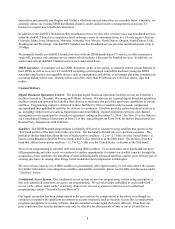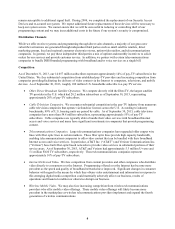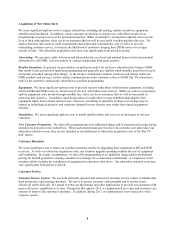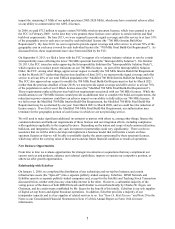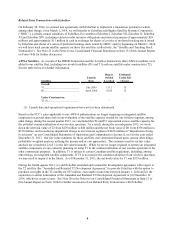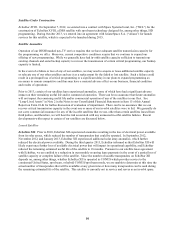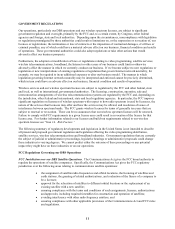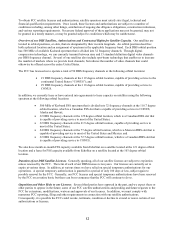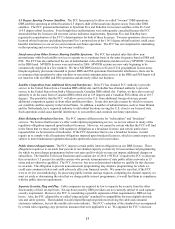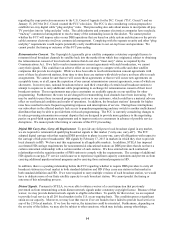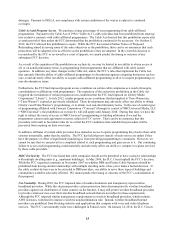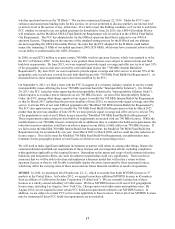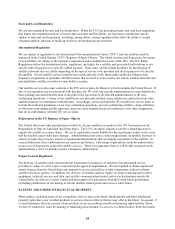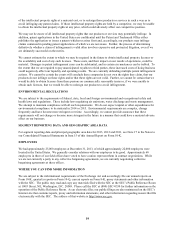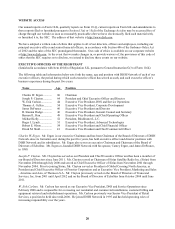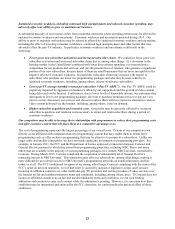Dish Network 2013 Annual Report Download - page 23
Download and view the complete annual report
Please find page 23 of the 2013 Dish Network annual report below. You can navigate through the pages in the report by either clicking on the pages listed below, or by using the keyword search tool below to find specific information within the annual report.13
13
4.5 Degree Spacing Tweener Satellites. The FCC has proposed to allow so-called “tweener” DBS operations –
DBS satellites operating at orbital locations 4.5 degrees (half of the usual nine degrees) away from other DBS
satellites. The FCC granted authorizations to Spectrum Five and EchoStar for tweener satellites at the 86.5 and
114.5 degree orbital locations. Even though these authorizations were subsequently cancelled because the FCC
determined that the licensees did not meet certain milestone requirements, Spectrum Five and EchoStar have
requested reconsideration of the FCC’s determinations for both of these licensees. Tweener operations close to our
licensed orbital locations (including Spectrum Five’s proposed use at the 114.5 degree orbital location) could cause
harmful interference to our service and constrain our future operations. The FCC has not completed its rulemaking
on the operating and service rules for tweener satellites.
Interference from Other Services Sharing Satellite Spectrum. The FCC has adopted rules that allow non-
geostationary orbit fixed satellite services to operate on a co-primary basis in the same frequency band as DBS and
FSS. The FCC has also authorized the use of multichannel video distribution and data service (“MVDDS”) licenses
in the DBS band. MVDDS licenses were auctioned in 2004. MVDDS systems are now only beginning to be
commercially deployed in a few markets. We have MVDDS licenses in 82 out of 214 geographical license areas.
Despite regulatory provisions intended to protect DBS and FSS operations from harmful interference, there can be
no assurance that operations by other satellites or terrestrial communication services in the DBS and FSS bands will
not interfere with our DBS and FSS operations and adversely affect our business.
Satellite Competition from Additional Slots and Interference. DirecTV has obtained FCC authority to provide
service to the United States from a Canadian DBS orbital slot, and EchoStar has obtained authority to provide
service to the United States from both a Mexican and a Canadian DBS orbital slot. Further, we have also received
authority to do the same from a Canadian DBS orbital slot at 129 degrees and a Canadian FSS orbital slot at 118.7
degrees. The possibility that the FCC will allow service to the U.S. from additional foreign slots may permit
additional competition against us from other satellite providers. It may also provide a means by which to increase
our available satellite capacity in the United States. In addition, a number of administrations, such as Great Britain
and the Netherlands, have requested authority to add orbital locations serving the U.S. close to our licensed slots.
Such operations could cause harmful interference to our satellites and constrain our future operations.
Rules Relating to Broadcast Services. The FCC imposes different rules for “subscription” and “broadcast”
services. We believe that because we offer a subscription programming service, we are not subject to many of the
regulatory obligations imposed upon broadcast licensees. However, we cannot be certain whether the FCC will find
in the future that we must comply with regulatory obligations as a broadcast licensee, and certain parties have
requested that we be treated as a broadcaster. If the FCC determines that we are a broadcast licensee, it could
require us to comply with all regulatory obligations imposed upon broadcast licensees, which in certain respects are
subject to more burdensome regulation than subscription television service providers.
Public Interest Requirements. The FCC imposes certain public interest obligations on our DBS licenses. These
obligations require us to set aside four percent of our channel capacity exclusively for noncommercial programming
for which we must charge programmers below-cost rates and for which we may not impose additional charges on
subscribers. The Satellite Television Extension and Localism Act of 2010 (“STELA”) requires the FCC to decrease
this set-aside to 3.5 percent for satellite carriers who provide retransmission of state public affairs networks in 15
states and are otherwise qualified. The FCC, however, has not yet determined whether we qualify for this decrease
in set-aside. The obligation to provide noncommercial programming may displace programming for which we
could earn commercial rates and could adversely affect our financial results. We cannot be sure that, if the FCC
were to review our methodology for processing public interest carriage requests, computing the channel capacity we
must set aside or determining the rates that we charge public interest programmers, it would find them in compliance
with the public interest requirements.
Separate Security, Plug and Play. Cable companies are required by law to separate the security from the other
functionality of their set-top boxes. Set-top boxes used by DBS providers are not currently subject to such separate
security requirement. However, the FCC is considering a possible expansion of that requirement to DBS set-top
boxes. Also, the FCC adopted the so-called “plug and play” standard for compatibility between digital television
sets and cable systems. That standard was developed through negotiations involving the cable and consumer
electronics industries, but not the satellite television industry. The FCC’s adoption of the standard was accompanied
by certain rules regarding copy protection measures that were applicable to us. We appealed the FCC’s decision


